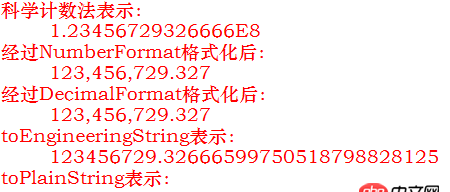java - 如何准确的将科学计数法表示的Double类型转换为正常的字符串?
问题描述
1.起因最近在做Excel解析,要知道,在Excel中会将长数字自动转换为科学计数法表示,我的问题是如何原样 读取出来并用字符串表示,为了方便说明,我新建一个Workbook,在第一个Sheet的第一个Cell中填入: 123456729.326666,Excel中显示为:

现在我需要利用POI将其读取出来,并原样打印:123456729.326666。2.我的代码如下:
public static void main(String[] args) throws FileNotFoundException, IOException {String filePath='C:/Users/yan/Desktop/testDouble.xlsx';File file = null;InputStream is = null;try { file=new File(filePath); is = new FileInputStream(file); XSSFWorkbook workbook = new XSSFWorkbook(is); XSSFCell cell1 = workbook.getSheetAt(0).getRow(0).getCell(0); //获取double类型的值 Double d = cell1.getNumericCellValue(); System.err.println('科学计数法表示:nt'+d);//此时打印出来是科学计数法 /** * 使用NumberFormat转换 */ NumberFormat nf = NumberFormat.getInstance(); String s = nf.format(d); System.err.println('经过NumberFormat格式化后:nt'+s); /** * 使用DecimalFormat转换字符串 */ DecimalFormat df = new DecimalFormat(); s=df.format(d); System.err.println('经过DecimalFormat格式化后:nt'+s); /** * 直接使用BigDecimal表示 */ BigDecimal bd = new BigDecimal(d); //转换为工程??我也不知道怎么称呼 s = bd.toEngineeringString(); System.err.println('toEngineeringString表示:nt' + s); //使用网上普遍的解决办法toPlainString s = bd.toPlainString(); System.err.println('toPlainString表示:nt' + s);} catch (Exception e) { e.printStackTrace();} }输出结果

可以看到,我并没有得到想要的结果(123456729.326666),使用*Format之后只保留3位小数,此处不设置#.####等格式是因为并不确定输入的小数可以达到多少位,继而使用了网上推荐的toPlainString方法得到的结果也并不精确,求各位大神指点。
问题解答
回答1:自问自答:使用cell.getNumericCellValue()得到double数据再转换成字符串doubleStr,当doubleStr.contains('E')为真时调用一下方法:
private static String getRealNumOfScientificNotation(String doubleStr) {int indexOfE = doubleStr.indexOf(’E’);int indexOfPoint = doubleStr.indexOf(’.’);// 整数部分BigInteger zs = new BigInteger(doubleStr.substring(0, indexOfPoint));// 小数部分BigInteger xs = new BigInteger(doubleStr.substring(indexOfPoint+ BigInteger.ONE.intValue(), indexOfE));// 指数int pow = Integer.valueOf(doubleStr.substring(indexOfE+ BigInteger.ONE.intValue()));StringBuffer buffer = new StringBuffer();// e.g. 1.23E-5if (pow < 0) { for (int i = 0; i < -pow; i++) {buffer.append(0); } buffer.insert(BigInteger.ONE.intValue(), '.'); buffer.append(zs.toString()).append(xs.toString()); doubleStr = buffer.toString();} else { int xsLen = xs.toByteArray().length; int needFill0 = pow - xsLen; if (needFill0 < 0) {// e.g. 1.234E2buffer.append(xs);buffer.insert(pow, '.');buffer.insert(0, zs);doubleStr = buffer.toString(); } else {// e.g. 1.234E6 or 1.234E3for (int i = 0; i < needFill0; i++) { buffer.append(0);}buffer.insert(0, xs);buffer.insert(0, zs);doubleStr = buffer.toString(); }}return doubleStr; }回答2:
double 本身就存在精度问题,可以用BigDecimal再转换一下,指定一下小数点位数再输出:
/** * 转换数值为指定位数 * @param value 原始数值的字符串表示形式 * @param scale 保留小数点位数 * @return 转换后的字符串 */public static String toStandardString(String value, int scale) { return new BigDecimal(value).setScale(scale, BigDecimal.ROUND_HALF_UP).toEngineeringString();}
toStandardString('123456729.32666599750518798828125', 6);// 输出为123456729.3266666
相关文章:
1. 我在centos容器里安装docker,也就是在容器里安装容器,报错了?2. node.js - Vue+Webpack在dev环境下没有问题build后出现莫名错误3. node.js - nodejs+express+vue4. javascript - Vue.js2.0不能使用debounce后大伙一般是如何解决延迟请求的问题的呢。5. javascript - immutable配合react提升性能?6. HTML属性7. 为什么网页要声明<!DOCTYPE html>8. css - 手机页面在安卓和苹果浏览器显示不同的小小问题9. mysql - python如何给微信小程序写后台?10. javascript - vue2.0中使用vue2-dropzone的demo,vue2-dropzone的github网址是什么??百度不到。

 网公网安备
网公网安备